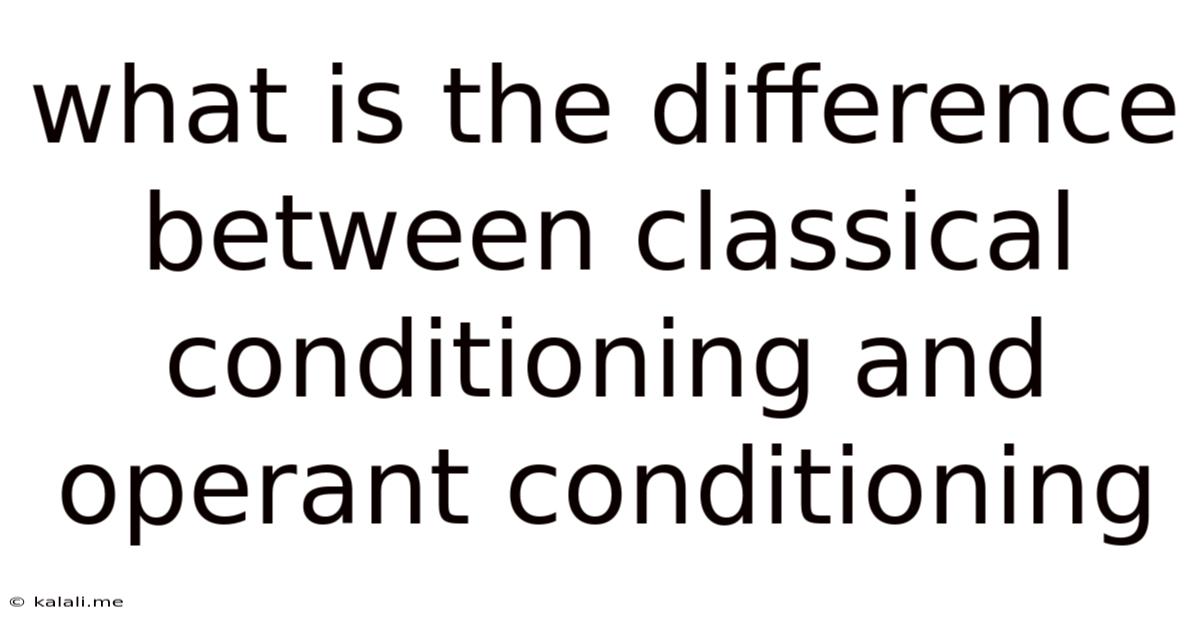What Is The Difference Between Classical Conditioning And Operant Conditioning
Kalali
Jun 11, 2025 · 3 min read

Table of Contents
Classical vs. Operant Conditioning: Understanding the Key Differences
Understanding the differences between classical and operant conditioning is crucial for anyone studying psychology or interested in learning how animals and humans learn. While both are learning processes involving associations, they differ significantly in how those associations are formed and the types of behaviors they affect. This article will delve into these key distinctions, providing clear examples to illustrate each concept.
What is Classical Conditioning?
Classical conditioning, pioneered by Ivan Pavlov, is a learning process where an association is made between a neutral stimulus and a naturally occurring stimulus. The naturally occurring stimulus, also known as the unconditioned stimulus (UCS), triggers an automatic, involuntary response called the unconditioned response (UCR). Through repeated pairings, the neutral stimulus becomes a conditioned stimulus (CS), eliciting a learned response called the conditioned response (CR), which is similar to the UCR.
Key Features of Classical Conditioning:
- Involuntary Responses: Classical conditioning focuses on involuntary, reflexive behaviors. Think salivation, fear, or arousal.
- Association Through Pairing: Learning occurs through the repeated pairing of a neutral stimulus with an unconditioned stimulus.
- Predictability is Key: The effectiveness of classical conditioning relies on the predictable association between the stimuli. The more consistently the CS precedes the UCS, the stronger the association.
Example: Pavlov's famous experiment with dogs. The UCS (food) elicited the UCR (salivation). After repeatedly pairing the sound of a bell (initially a neutral stimulus) with the food, the bell alone (now the CS) began to elicit salivation (the CR).
What is Operant Conditioning?
Operant conditioning, developed by B.F. Skinner, focuses on learning through consequences. Behaviors are strengthened or weakened depending on the consequences that follow them. This process involves reinforcement, which increases the likelihood of a behavior being repeated, and punishment, which decreases the likelihood of a behavior being repeated.
Key Features of Operant Conditioning:
- Voluntary Behaviors: Operant conditioning deals with voluntary behaviors that are emitted by the organism.
- Consequences Shape Behavior: Learning occurs through the consequences that follow a behavior.
- Reinforcement and Punishment: Reinforcement strengthens behavior, while punishment weakens behavior. Reinforcement can be positive (adding something desirable) or negative (removing something undesirable). Punishment can also be positive (adding something undesirable) or negative (removing something desirable).
Example: A rat pressing a lever (behavior) to receive a food pellet (positive reinforcement). The consequence (food) increases the likelihood of the rat pressing the lever again. Conversely, a rat receiving a mild electric shock (positive punishment) after pressing the lever will decrease the likelihood of it pressing the lever again.
The Crucial Differences Summarized:
| Feature | Classical Conditioning | Operant Conditioning |
|---|---|---|
| Type of Response | Involuntary, reflexive | Voluntary, emitted |
| Learning Process | Association between two stimuli | Association between behavior and consequence |
| Focus | Stimulus-response relationship | Response-consequence relationship |
| Key Concepts | UCS, UCR, CS, CR | Reinforcement (positive & negative), Punishment (positive & negative) |
Beyond the Basics: Interconnectedness and Applications
While distinct, classical and operant conditioning are not mutually exclusive. They can interact and influence each other. For example, classical conditioning can be used to create a conditioned emotional response (fear or anxiety), which can then be modified through operant conditioning techniques.
Understanding these principles has far-reaching applications in various fields, including:
- Therapy: Treating phobias, anxieties, and addictions.
- Education: Developing effective teaching methods and classroom management strategies.
- Animal Training: Training pets and other animals.
- Marketing and Advertising: Influencing consumer behavior.
By understanding the nuances of classical and operant conditioning, we gain valuable insights into the learning process and its powerful impact on shaping behavior across species.
Latest Posts
Latest Posts
-
How To Beat Stage 7 In Bloxorz
Jul 01, 2025
-
How Much Oz In A Bottle Of Water
Jul 01, 2025
-
How Long Does It Take To Drive 10 Miles
Jul 01, 2025
-
How Many 9s Are In A Deck Of Cards
Jul 01, 2025
-
How Many Pounds Are In 2 5 Kg
Jul 01, 2025
Related Post
Thank you for visiting our website which covers about What Is The Difference Between Classical Conditioning And Operant Conditioning . We hope the information provided has been useful to you. Feel free to contact us if you have any questions or need further assistance. See you next time and don't miss to bookmark.